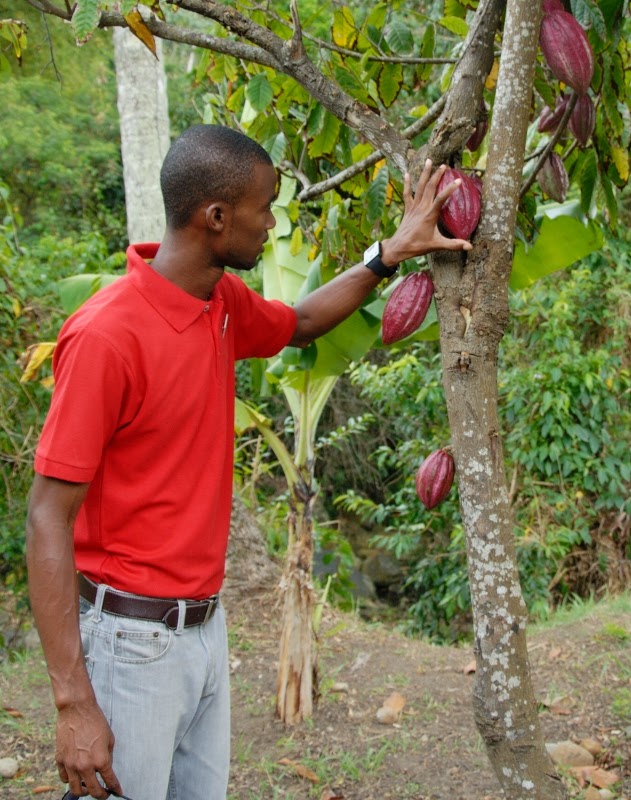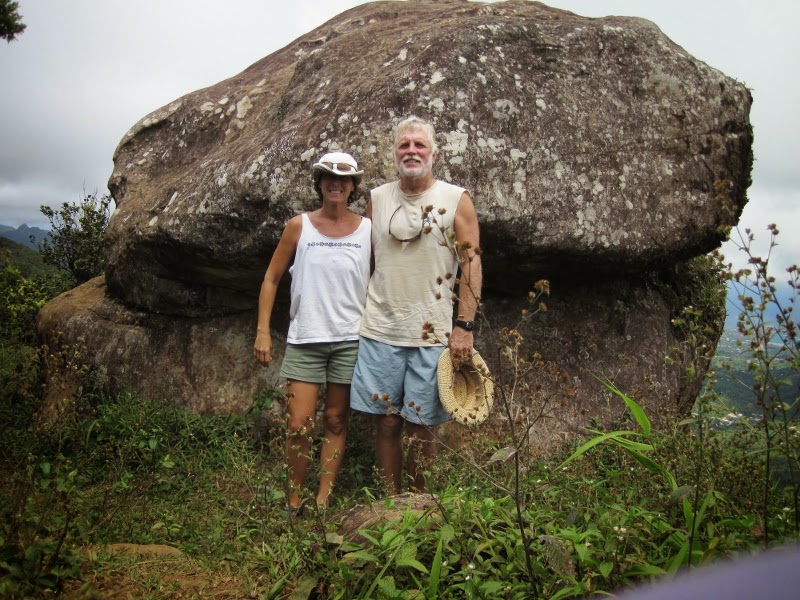I opted for the most basic title for this post instead of the more descriptive "Learning to Use a PC in a Hundred Easy Steps" (since my Mac is no longer working even sporadically) but the process of learning how to actually use said PC has sapped any extra creativity I may have had. Thus.... "Grenada".
We anchored in Prickly Bay and ended up staying for three weeks in the same spot. It was easiest to catch the local buses from the road near Prickly Bay and the other anchorages didn't really draw us.
.jpg) |
| Dinghy exploration with our buddies Trevor and Lynda |
We sailed past several anchorages on our way into Prickly Bay and met up with our friends Trevor and Lynda here. We first connected with them in Carriacou when we spotted their C&C 40 Impulsive in Tyrrel Bay. She and Saralane are sister ships and we spent a few nights in their comfortable company in both anchorages. Trevor is a Trini and Lynda a Canadian; though they lived in Canada for many years Trevor jokes that when he gets as far north as Carriacou the boat automatically turns around and heads south again. Not a fan of cold weather, Trevor.
.jpg) |
| Fishermen behind the boat in Prickly Bay |
Early on we bused into town to check things out, poke around the shops and wander the very hilly streets.
.jpg) |
| Handmade batiks at Art Fabrik in St George |
.jpg) |
| Sendall Tunnel, for cars and pedestrians, connects the two parts of the hilly town |
Another day we caught a bus north to Belmont Estates to see the Grenada Chocolate Factory which prides itself on it's "tree to bar" locally grown and locally produced chocolate. The chocolate here is GOOD. Really good. Here's a quick photo tour...
+(631x800).jpg) |
| Our enthusiastic guide Meeschak starts us at the cacao tree |
The pods are harvested and the beans are fermented in bins, then dried on huge racks both inside a greenhouse and outside in racks that roll back under the greenhouse for protection during wet weather.
 |
| Fermenting under leaves and burlap |
 |
| Beans drying inside |
 |
| Handful of beans |
 |
| Meeschak rolled out this rack of beans for us to see |
 |
| And then rolled it back in! |
I got to "walk the cocoa" (aka: shuffle through the cocoa) while he had the rack out... which is how the fermented beans are kept separated while they're drying.
 |
| Walking the cocoa |
 |
| Drummers keep the beat while workers walk the cocoa. |
They ran a pretty informative video on a loop before and after tours here and gave everyone copious amounts of different chocolate to try. We bought our share of Grenada chocolate in the little shop here before we left which I'm hoarding on the boat.
.jpg) |
| Beans I bought and roasted. The papery outer layer comes off and voila... cocoa nibs. |
.jpg) |
| I may not share.... |
Nearby was the River Antoine Rum factory that we toured too. Almost all the work here is still done by hand and it was hot, sweaty and not especially safe looking work.
+(800x536).jpg) |
| Sugar cane on the conveyor belt headed for the crusher |
+(800x536).jpg) |
| Water from the river runs the wheel to power the conveyor belt and crusher |
+(800x536).jpg) |
| Standing by with a machete at the top of the conveyor to whack at any stalks that aren't cooperating |
+(800x536).jpg) |
| An attempt at safety...this worker tied a cloth around his face to keep from inhaling the residue from the cane waste he's burning. |
+(800x536).jpg) |
| Vats of hot sugar cane juice..... |
+(800x536).jpg) |
| .... ferment in big open pits. |
Our guide Mavis, who has clearly done this tour one too many times, finished up the tour by pouring some of River Antoine's finest for us to taste. We cautiously sniffed the fiery samples she poured and she barked, "Don't play with it! Just drink it!" Yes ma'am.
+(800x536).jpg) |
| Do what Mavis says.... or else! |
Boat projects, errands (like finding a Mac repair place) and other work kept us close to the anchorage more than we expected but we did get out for a few hikes... first to Mt Qua Qua, the second highest peak on the island, and then to Concord Falls just up the west coast and inland a bit. Busing to both took a little patience and a lot of faith in the drivers and the expertise of the auto mechanics that work on the buses.
Like a lot of the islands, buses are just big mini vans that don't leave the station until there's no breathing room left inside. If you catch a bus outside of the stations or the bus stops you almost have to jump in while they're still moving because the drivers can be heavily fined if they're caught picking up passengers anywhere other than stations or stops.
In Grenada most buses also had a conductor, which is just a fancy way of describing the surly teenage boys that sat by the sliding door to let people in and out and collect the small fees for riding. It was up to them to drum up business and each one had a different technique. Mostly they just yelled out the window to everyone "heywhereyougoingwhereyougoing?goingtoStGeorge?needabus?needabus?takethebus!
comecomehurryhurrygetingetin!" The drivers would screech to a halt, back up at random, take meandering high speed detours to buy food from street vendors or do some grocery shopping, pick up and drop off friends and school kids, all while blaring their favorite music at top volume.
 |
| Bus station in St George |
My photo doesn't begin to capture the chaotic energy of the bus station, or the noise or dust or heat. Nor does it capture the pleading sound of the young preacher who was always there waving his tattered bible and imploring riders and passersby to come to Jesus. I'll bet he's gotten some converts too.... namely people who've made it off the bus after an especially hair raising trip. The roads are steep and windy and more than once I found myself wishing the driver would pay more attention to the road than to his cell phone.
 |
| This driver's got religion... |
But, I digress. Back to hiking. Our bus dropped us at Grand Etang where we picked up the Mt Qua Qua trail head. About an hour and a half of uphill hiking brought us to the top of the peak and gave us some fabulous views and cool breezes.
.jpg) |
| Looking back at Grand Etang |
.jpg) |
| Looking east toward Africa! |
.jpg) |
| Fork in the road |
.jpg) |
| Set self timer... hurry to get in photo without tripping and falling. |
I caught up on my flora shots along the way...
 |
| Fern, curled. |
.jpg) |
| I'd love to have an ID on this funky pod/blossom |
The clouds rolled in as we reached the top of Mt Qua Qua and we sat in the mist until it cleared before retracing our steps to the bottom. Two bus rides later we were back at the anchorage.
Since this has apparently turned into a mega-blog (sorry for not giving fair warning) I'll just carry on and finish up with all things Grenada while I'm on a roll.
More hiking.... another day and another bone rattling couple of bus rides and we were on our way to hike to Concord Falls. It was an easy hike that took us through farmland and across several streams. The farms were small and neat and rows of herbs, carrots, tomatoes, cabbage, beans, callaloo, potatoes and dasheen shared space with all kinds of trees; cacao, bananas, nutmeg, carambola, cashew, avocado, mango, soursop, breadfruit and more. Like in Dominica... food falls from the sky here.
.jpg) |
| Yet another photo of cacao pods growing. Can't get enough of them. |
.jpg) |
| Nutmeg |
.jpg) |
| Lone papaya on the way to Concord Falls |
.jpg) |
| Callaloo/Dasheen |
Concord Falls is really three waterfalls and we went to the second one, called Au Coin. It's a peaceful lovely waterfall and we spent our time there in the quiet company of a local guy who came to just sit and enjoy the simple beauty of it.
Had enough of Grenada for now? I'm not sure we have but it seemed like time to move on so we sailed up the west coast and after a stop to snorkel the overrated (really... don't bother going there) underwater park in Dragon Bay, we spent the night in Halifax Harbor. Halifax Harbor is where the island's trash gets um.... deposited and burned. Okay... fine... it's where the dump is. And not only is the dump there, but there are power lines strung across the shores making it impossible to tuck in to the harbor unless your mast is less than the guestimated 60 feet. And really... are you willing to take that chance?
We snugged up to the north shore and had a really quiet night. What with the dump and the power lines.... of course we were the only ones there!
.jpg) |
| Can't.... breathe.... underwater.. |
.jpg) |
| Praying to be released from the underwater park |
.jpg) |
| The upside? In a marine park, the fish are much more plentiful. |
.jpg) |
| Village on the west coast |
.jpg) |
| Pretty (and odor free) Halifax Harbor. Note the power lines at 60ish feet above the water. |
So in a (giant) nutshell.... that's our time in Grenada. As always I've left out a lot and probably included too many photos of cacao pods, but I'm more or less caught up. We've started heading north and are currently in Bequia where a big north swell has made it's way down and is rocking and rolling all the boats in the anchorage. We'll stay another day or so and then continue on north....
.jpg)
.jpg)
.jpg)
.jpg)
+(631x800).jpg)







.jpg)
.jpg)
+(800x536).jpg)
+(800x536).jpg)
+(800x536).jpg)
+(800x536).jpg)
+(800x536).jpg)
+(800x536).jpg)
+(800x536).jpg)


.jpg)
.jpg)
.jpg)
.jpg)

.jpg)
.jpg)
.jpg)
.jpg)
.jpg)
.jpg)
.jpg)
.jpg)
.jpg)
.jpg)

.jpg)


.jpg)
.jpg)
.jpg)
.jpg)
.jpg)
.jpg)
.jpg)









